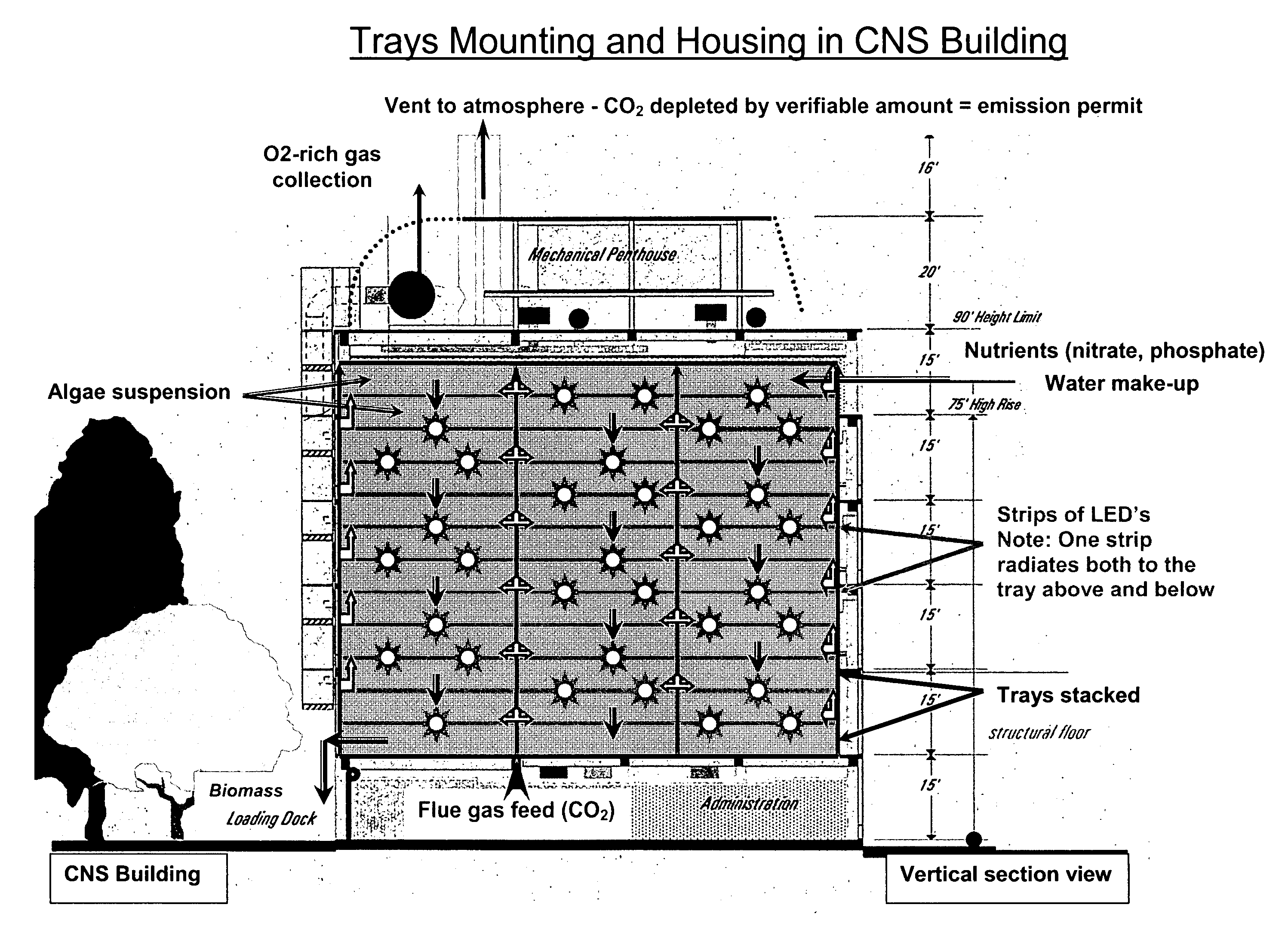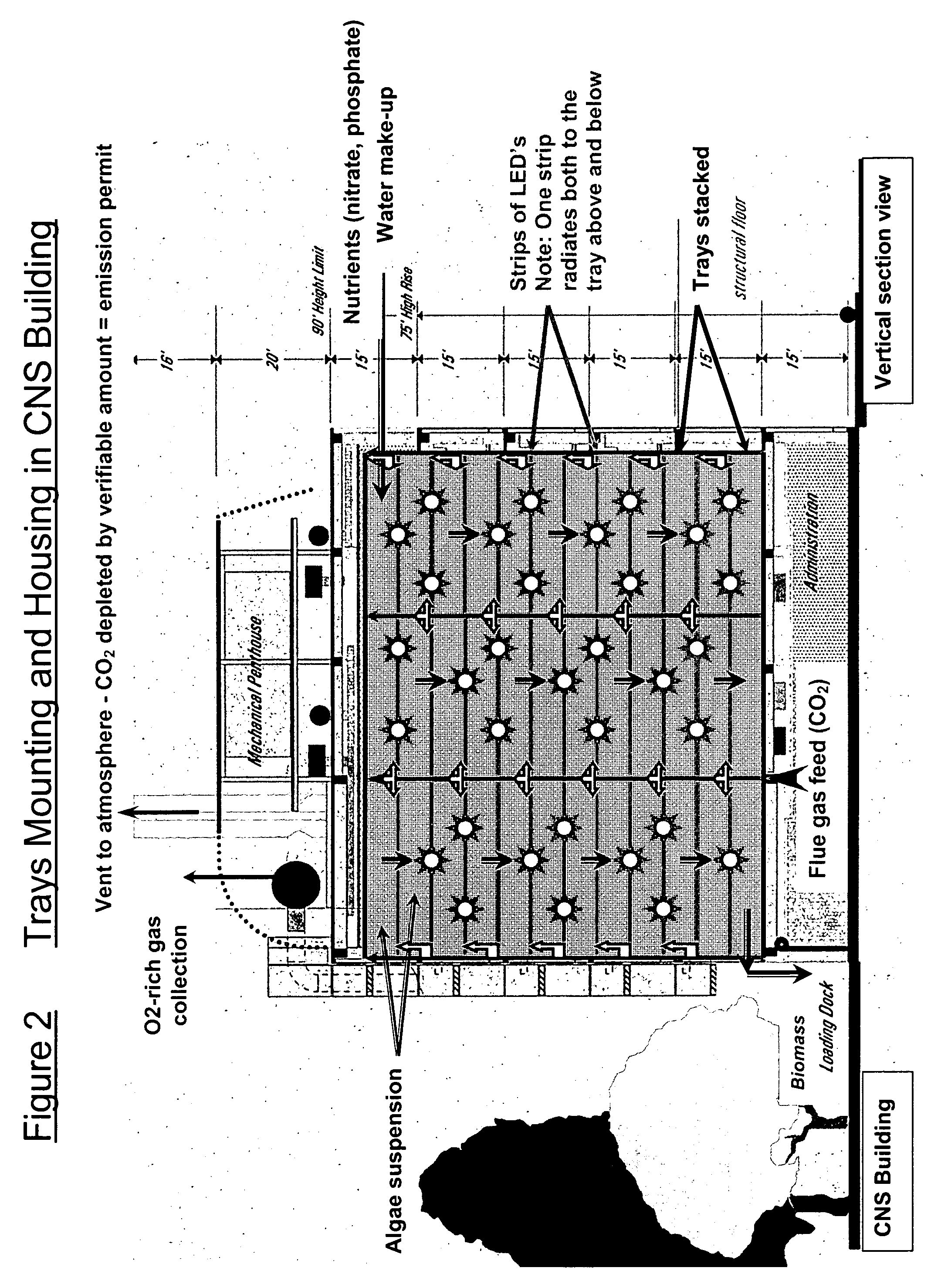[0019] The current invention includes a continuous process photo-
bioreactor and method of operating said bioreactor using flashing light emitting diodes (“LED's”) to artificially force and accelerate
chlorophyll based
photosynthesis in
blue green algae (cyano-
bacteria) and other related, uni-
cellular organisms, either naturally occurring, derived there from, manipulated / created by artificial means or otherwise cultivated. The LED's preferably emit light tightly centered on a
wavelength of 660 nm to optimize carbon dioxide sequestration while minimizing energy costs. The sequestered carbon dioxide can emanate from, for example,
flue gas stacks from large stationary sources such as power plants,
cement works and the like that burn
solid, liquid or gaseous hydrocarbons.
[0020] The increase in carbon dioxide sequestration is realized by accelerating and compressing the natural, day-night diurnal cycle to a fraction of its
natural cycle time, preferably milliseconds, by flashing the LEDs. The minimization of the energy costs is achieved by electronically linking the LED's
light cycle and light fraction time to the
oxygen content and other measures of the culture (
oxygen output being a measure of photosynthetic activity), so that the culture can be automatically kept at or near the maximum photosynthetic rate for the prevailing conditions of nutrients, gas flow, CO2 concentration, and the like. To achieve these results, it is anticipated that the “flash” will preferably last in the order of pico to micro seconds, and that the subsequent
dark period will be in the approximate range of milli seconds up to about one second.
[0022] The process and apparatus would minimize energy costs in a number of ways. Much of the
energy conservation is achieved by using carefully controlled flashing LED's that emit light tightly centered on a
wavelength of 660 nm. The
photon (light)
stream from the LED's is intermittent (i.e. broken up), which saves energy as compared to continuous lighting. The LED's preferably emit light only at the very narrow
wavelength required by the
chlorophyll in the
algae, which increases the energy efficiency of the
system. Furthermore, the light-dark cycle times are controlled so as to match the overall
photosynthesis cycle (PS I+PS II+the dark [Calvin] cycle), thus maximizing carbon dioxide uptake. Phyto-inhibition, which occurs at excessive light levels, is largely avoided, and the
algae are photo-acclimated to grow in low average light levels.
[0023] The bioreactor apparatus of the present invention preferably includes a sealed housing or building having a series of stacked, generally parallel trays running there through, each of wide rectangular profile. They are preferably inclined slightly from the horizontal. Energy savings are achieved by arranging the bioreactor horizontally, rather like the tubes in a contemporary, steam-raising boiler. This orientation saves energy because it obviates most of the
mass flow and control problems that are seen in vertically arranged bio-reactors. Very little energy is expended in pumping a culture through a horizontal
system, since most of the flow is achieved by orienting the horizontal bioreactor slightly downhill. As a result, most of the flow is due to gravity, with the remainder being achieved by the flowing of the gas. Due to the
horizontal orientation, only minimal energy is needed to run the pump to return the aquatic culture to the top end of the bioreactor. For instance, a low-pressure, “
Archimedes Screw” pump can be used to gently return the aquatic culture to the top end of the reactor using very little energy. The
water cycle within the
system is almost closed, only requiring makeup water to compensate for some
evaporation through the gas vents, and some water entrained with the harvested
algae.
[0024] As a further
advantage, because the reactor trays are modular, and hence stacked, the system is easily scaled, for example, from a 16 MW gas
turbine right through a huge 16,000 MW
power station. Such
modularity of construction, and hence
scalability, has not been seen in other photo-bioreactors. Further, the
modular design allows different strains of
bacteria to be grown in different groups of trays, if desired.
[0025] Finally, as the reactor trays are horizontal and modular, maintenance of the trays will be easy. For major overhauls, the trays can be pulled from the
assembly, rather like the current procedure for cleaning and de-scaling boiler tubes. For intermittent, in-situ cleaning, which is important to avoid algal
fouling of the LED's radiant surfaces, a low-power
red laser can be swung to the ends of the temporarily emptied tray channel. The
laser will quickly scan the interior of the channels in a pre-set pattern, thus burning off any organic residues without
scratching the
polycarbonate, optical surfaces. For longer tray lengths, a small, trolley-mounted
red laser can be pulled through the tray while rotating rapidly in order to achieve de-
fouling. It is known that live
Chlamydomonas Reinhardtii cells can be made to rotate while pinned in a
laser “trap.” The energy of the
light beam can thus be used to manipulate and trap cells much like the way that the wind moves objects of a larger scale. Hence the
laser approach described above can also be effective as a cleaning device in association with the present invention.
 Login to View More
Login to View More  Login to View More
Login to View More 


